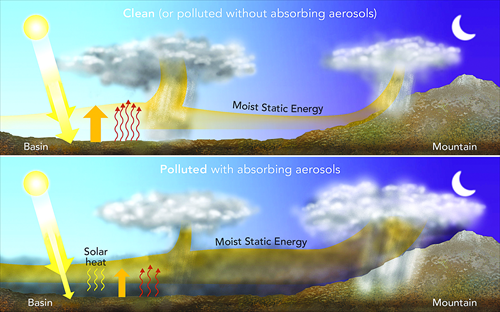Top scientist shows how smog amplified flooding in SW China

Fan Jiwen in her office Photo: Courtesy of Fan Jiwen

A diagram displaying Fan's findings Photo: Courtesy of Fan Jiwen
While it is widely known that smog is hazardous to your health, scientists have recently discovered that air pollution can also result in extreme weather conditions such as floods and droughts.
Fan Jiwen, a widely respected expert in atmospheric science from the Pacific Northwest National Laboratory (PNNL), a US Department of Energy-affiliated research laboratory in Richland, Washington, is a leading figure in this area of study.
After two years of research in which simulations were combined with real-life observations, she and her research team published findings showing that man-made air pollution had substantially contributed to the catastrophic floods that hit Southwest China in July 2013.
Between 8 and 13 July in 2013, the western Sichuan Basin witnessed rare torrential rainfall, which caused severe floods and landslides. According to official figures, as of 15 July, 68 people had died, 179 people had gone missing, 13,000 houses had collapsed and 286,000 people were relocated. The direct economic losses came to 20 billion yuan ($3.1 billion).
But according to Fan's study, the disaster could have been less severe if the air quality in the region had not been so poor. "Our modeling and simulation results show that if the emissions level had been the same as it was in the late 1970s, the extreme precipitation in the mountainous region would have dropped by up to 40 percent, and only minor precipitation would have occurred in the basin," Fan told the Global Times via telephone.
Published in the scientific journal Geophysical Research Letters, the study was highlighted by leading international scientific publications, such as Nature and Science.
Making the connection
Fan, 41, a Chinese American who has worked at PNNL since 2007, has devoted her career to untangling the connections between aerosols, clouds, and the climate.
In July 2013, while watching TV news footage of the Sichuan storm, she was shocked by the intensity of the rainstorms.
"While I grieved over the casualties and damages, I was surprised by the fact that the heavy rainfall mainly occurred downwind in mountainous regions, instead of the broad basin area," Fan recalled.
The Sichuan Basin is notorious for its air pollution due to the area's urban development and industrialization, as well as special geographical features that hinder air circulation, Fan said.
"When Daniel Rosenfeld [an Israeli meteorology professor from the Hebrew University of Jerusalem] and I chatted about this catastrophic flood, both of us believed there was a connection between the severe air pollution in the basin, especially the high content of black carbon [a type of sunlight-absorbing aerosol], and the extremely heavy storms," she said.
Fan and her team, consisting of a PhD student, two colleagues from PNNL, Rosenfeld, and Li Zhanqing, another noted expert on meteorology from the University of Maryland and Beijing Normal University, carried out simulations.
The first challenge was collecting accurate data on real emissions and precipitation in the region during that period, which was key to their confidence in the simulation results.
"Thanks to the close collaborations among the co-investigators from three countries [China, US and Israel], the model-based findings are firmly supported by reliable observation data," Fan said.
Her findings were different from the explanations given by the China Meteorological Administration, which announced in August 2013 that the rainstorm in Sichuan had resulted from a stable subtropical high atmosphere pressure and strong summer monsoons.
"We are very confident about our findings, since the precipitation amount every hour in our simulations was in exact agreement with the data collected by Chinese monitoring stations in Sichuan at that time," she said.
Her team's findings have received a great deal of attention in China, where in recent years more and more cities have been plagued by smog resulting from the tiny particles that make up heavy air pollution.
It's not her first study about aerosols - tiny particles in the air such as black carbon, salt or dust on which cloud droplets can form - in China. In 2012, after conducting computer simulations and field investigations in Shouxian county, Anhui Province, Fan and her colleagues published studies and reported that pollution increased heavy precipitation and warming in the upper atmosphere by enlarging storm clouds.
Humble beginnings
Born in 1974 to a poor family in a mountainous village in Longhui county, Hunan Province, Fan never imagined she would grow up to be a scientist. The eldest child of the family, Fan has two sisters and one brother. When she was a child, her biggest wish was to study hard and graduate early so she could find a good job to help relieve her family's poverty.
Despite doing well in high school, in order to save on college expenses she chose to go to Xiangtan Normal University (now Hunan University of Science and Technology) to study chemistry, which granted students subsidies every month.
In 1996, while applying for her graduate studies, she received three offers from top universities in Beijing. She chose to study environmental science at the China University of Mining and Technology. "I care about the environment we live in, and I like to do work related to it," she said.
Her first job after getting her master's degree was as an environmental engineer at Tsinghua Unisplendor Group. She researched and developed chemical additives to reduce level of sulfur dioxides in industrial emissions.
In 2000, she went to the US for further air quality-related studies and obtained a doctorate in atmospheric sciences at the Texas A&M University in 2007.
Now a mother of two, she continues to actively pursue her career. In July, she won the 2015 American Geophysical Union (AGU) ASCENT award, a prestigious achievement for mid-career scientists, for her contributions to improving our understanding of physical processes in aerosol-cloud interaction.
She hopes that her research will help people understand the impact of human activities on the weather and climate so as to improve our ability to forecast extreme weather events and make policy on emissions reduction.
"Pollution is a global issue since there are no borders for atmosphere circulation. We will continue to study the effect pollution has on weather and climate in those severely-polluted regions," she said. "For different regions, due to different meteorological conditions and geography, the effects can be very different because of different processes."
Newspaper headline: Smoke in the water